We are republishing this article written by retired UE Political Action Director Chris Townsend about our union’s history, principles and importance to the broader labor movement.
In late March of 1936, a stalwart group of unionists in the electrical and radio manufacturing industries gathered in snowy Buffalo, New York, to found what quickly became the third largest union in the CIO upsurge. The various streams of unionism that converged in Buffalo represented the grizzled union diehards in the manufacturing shops of some of the biggest corporations in the country; General Electric, General Motors, Westinghouse, and RCA among them. It also included new faces, young militants, workers energized by the overall left-wing growth in response to the catastrophe of the Great Depression.
The founding convention had barely ended when a strong section of metal workers — who had toughed it out as part of the independent Trade Union Unity League (TUUL) — sought affiliation. Thus was born the United Electrical, Radio and Machine Workers of America (UE), the first new industrial union chartered by the Congress of Industrial Unions (CIO).
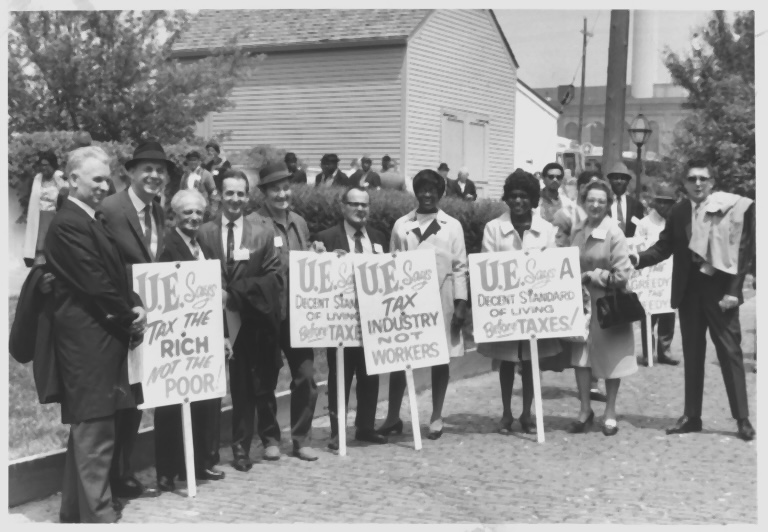
UE has never shied away from taking on the issues of the day.
In the nearly nine decades since UE’s founding, myriad histories and studies have been conducted on the union, its history, its functioning, its countless travails and many battles. Book upon book and articles too numerous to mention have been produced. Some have merit, probably most do not. Because the writers who have written about and studied UE over these many years include a huge proportion who were not dedicated to telling the truth about this remarkable union at all, but were instead a part of the immense well-paid machinery that was committed to the total destruction of UE and all that it has stood for.
UE Survived
It is safe to say that no U.S. union has suffered and withstood such an extreme degree of government and corporate repression as UE — and survived it — with the exceptions of the west coast Longshore and Warehouse Union (ILWU) and the Industrial Workers of the World (IWW). While always a militant and activist union, UE found itself by the late 1940s beset on all sides by McCarthyite forces launching attacks of every imaginable variety. At any given time in that period the union was being raided, investigated, prosecuted, spied-on, infiltrated, disrupted, and slandered, all to a degree difficult to comprehend today. At any given moment thousands of UE’s leaders and members were either already in jail, under indictment, fired, blacklisted, hounded relentlessly by the secret police, or facing deportation.
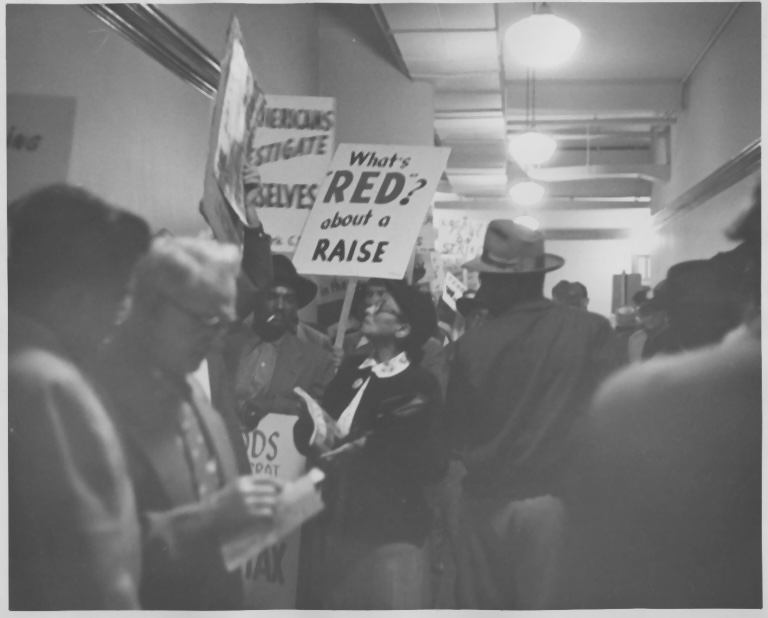
UE members, under attack by McCarthyite witch-hunters, fight back, asking “What’s red about a raise?”
As a result, UE faced internal turmoil to an unimaginable degree. Right-wing, opportunist, and company union forces welcomed the outside interference as they all jockeyed to grab a piece of the union for themselves in the carnage. The employers all aided the sabotage and wrecking by the corrupted elements, seeing an even more profitable future without UE’s resistance. Countless UE stalwarts and militants were dragged out of the union forcibly, as the first 200,000 members robbed from UE were done as a result of the union being barred from the NLRB ballot entirely.
Every legal and illegal tactic was justified as a fight “against communism.” Legions of paid informers took the witness stands to perjure themselves and provide the government with excuses to frame-up, fire, and jail these workers. UE leaders later referred to these monstrous episodes as “the dirty decade.” That is an understatement if ever there was one.
A Different Union, a Better Union
The women and men who built UE into the partisan working-class trade union organization that it remains today were guided not just out of the necessity of building a new union, but by the sincere dedication to create an entirely new and better union. Unfortunately, and frequently deliberately, the remarkable aspects of UE structure and practice are ignored by detractors and many scholars.
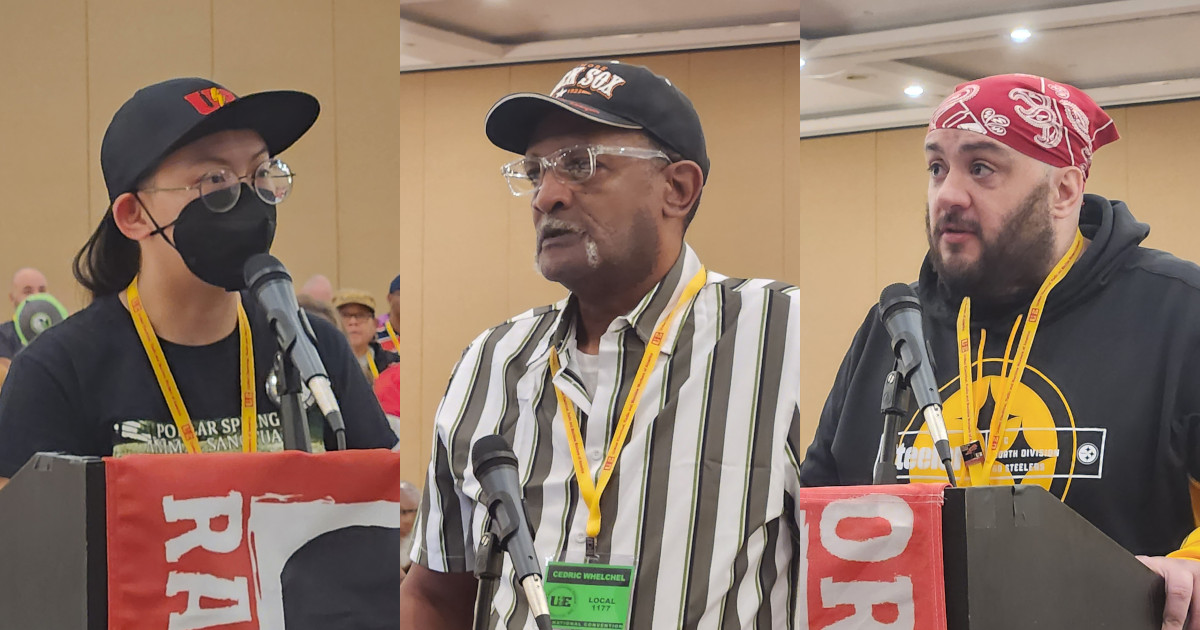
UE members speaking on the floor of the union’s 2023 convention in Pittsburgh.
Here is just a partial listing of UE’s characteristics that will stun most union members and labor movement activists. In no particular order, UE:
- Pays its three national officers no more than the highest wage earned by a working member, and provides those officers with the same benefits as other staff.
- Holds a convention every two years where 100% of the delegates are rank-and-file members, not paid staff members controlled by the leadership.
- Elects convention delegates at the local level, by democratic vote.
- Runs an open convention, with no beefy “security” to keep the members out or harass them at the behest of the “leaders” controlling all aspects of the Convention.
- Allows the member-delegates to speak to the body multiple times if desired.
- Convenes its convention in cities where UE members live and work, not junketeering and corrupting destinations like Las Vegas.
- Makes an open, detailed, and complete financial report to the convention with ample time for questioning and discussion.
- Conducts the convention democratically and sets union priorities and positions on union and political issues by democratic vote.
- Maintains a union absent the dreaded and coercive “trusteeship” clause, one of the most abused aspects of many business unions.
UE: An Alternative to Business Unionism
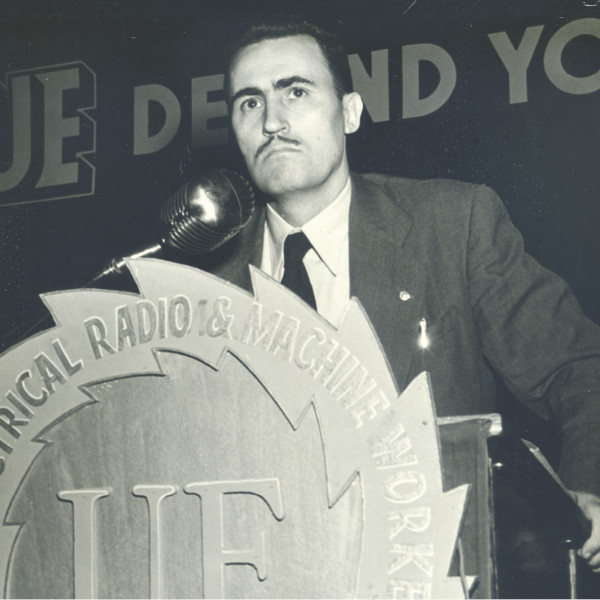
Jim Matles.
Founding UE Director of Organization was Romanian immigrant and metal worker James Matles, later the General Secretary-Treasurer of the union. Matles was known for his militant and hard-charging style and his command of union principles, strategies, and tactics. He was persecuted non-stop by the bosses and politicians. He spared nothing in his dissection of the failed and corrupt business union world. After being elected and re-elected annually for 38 years he retired in late 1975, only to pass away suddenly less than a week after his final Convention. In probably his last act as a UE officer he addressed a staff and local leader meeting in the central valley of California, then the site of considerable UE organizing activity.
Matles offered in his meeting comments that, “…the combined forces of the set-up failed to liquidate UE for all time, they failed to extinguish us, kill us off…. So, if you hope to play any serious role in the labor movement in the days to come, you must study the UE as an outstanding example of a rank-and-file union…” His retirement speech and its introduction by longtime UE General President Albert Fitzgerald remains a hallmark in UE history and in the more broad history of member-driven militant unionism.
And perhaps most important of all, the book authored by Jim Matles and his longtime friend James Higgins, “Them and Us: Struggles of a Rank-and-File Union” is mandatory reading for all grappling with the situation facing the working class in the United States today. Also check out UE’s pamphlet produced for the membership just several years ago in 2020 to explain and perpetuate the philosophy of UE.
UE Rebuilds
The very survival of UE as a national union is as remarkable as the principles and practices of the union. The political and corporate assault had barely begun to recede in the 1960s when the scourge of plant closings and the deep impact of new technologies began to rob the union of members from coast to coast. But consistently led at the national and local level by successive generations of unionists dedicated to clean, aggressive unionism, UE persevered and dug in for the long haul. Decade after decade these real leaders resolved to maintain a union dedicated to several key principles: to pursue aggressive struggle at all times; to maintain rank and file control; preserve and practice political independence for the union; to confront inequality and discrimination of all kinds and apply trade union solutions vigorously; and work for international solidarity with the ultimate goal of unity with all workers worldwide.
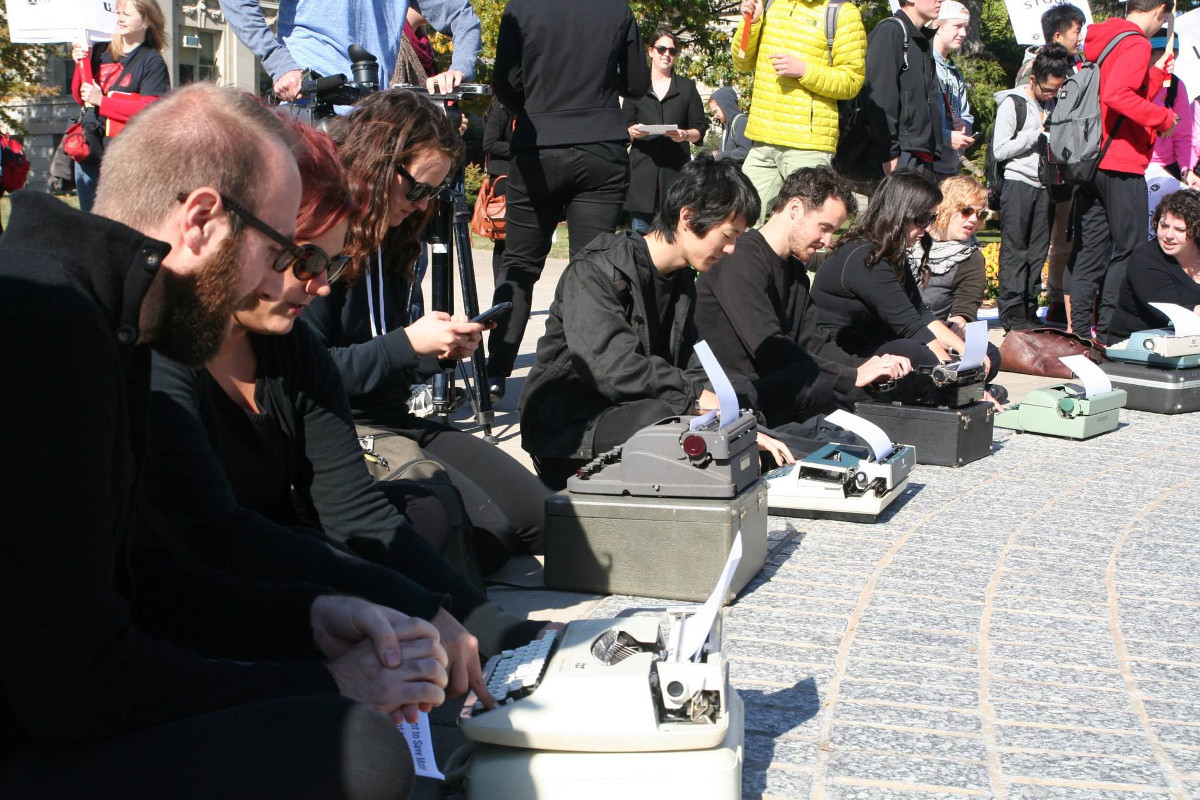
Above: Members of UE Local 896-COGS, UE’s first graduate worker local, stage a “type-in” protest, with old typewriters from thrift stores, after the University of Iowa president told them that they waste too much money on “lifestyle” amenities such as computers and cell phones. Below: Rail crew drivers, another important sector of workers UE has organized in recent decades, rally for a first contract.
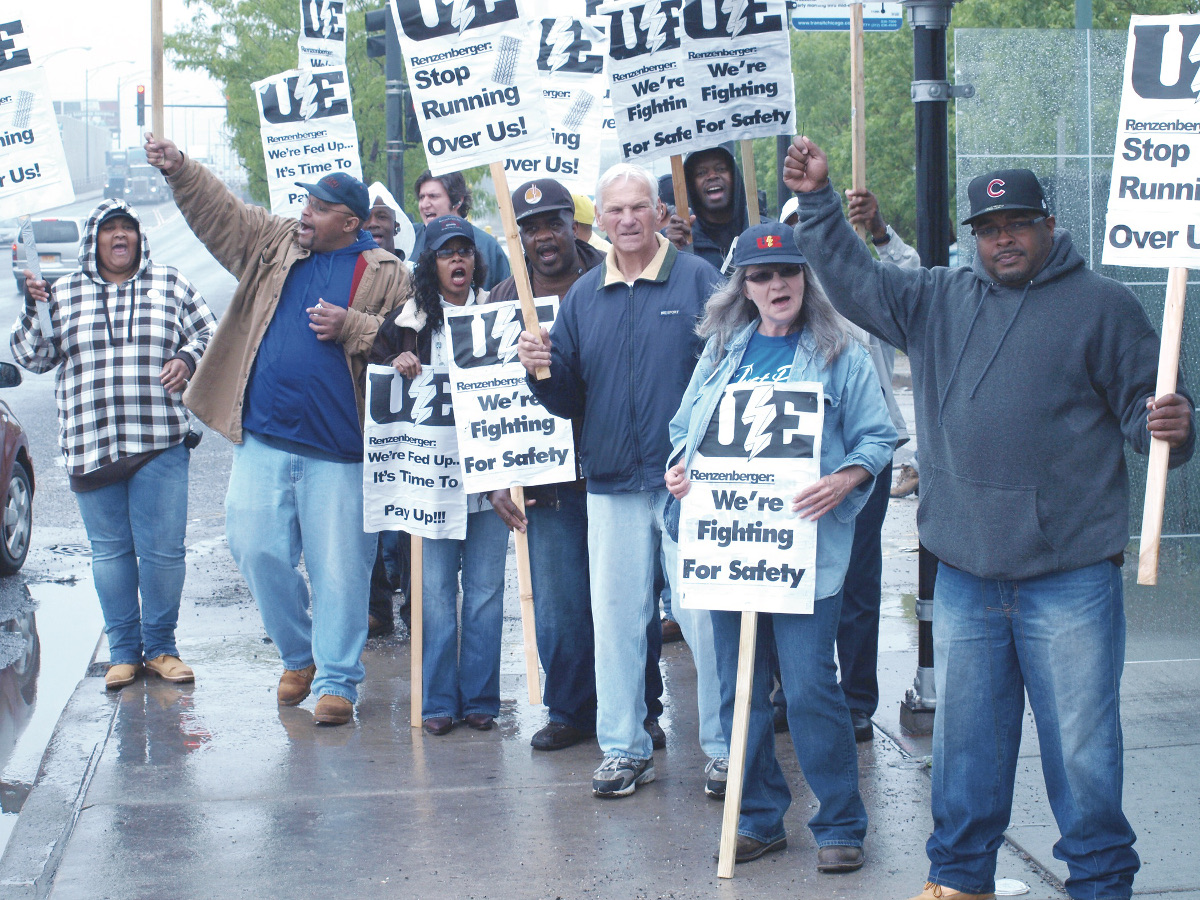
By the 1990s, UE found itself once more in deep and turbulent waters as the huge U.S. manufacturing base was systematically destroyed and shipped overseas by a criminal alliance of corporate leaders and politicians in both political parties. As union after union collapsed and disappeared altogether, UE soldiered on and fought day after day, and year after year to survive. It was a struggle to fight today, but also to find a way to fight tomorrow. Expanding for the first time into new industrial sectors, workers desiring a strong, democratic and aggressive union steadily flowed into UE. Today, the membership composition no longer represents anything that would be recognized by the founders in Buffalo. UE today represents workers in 100 or more different occupations; public and private employees, service staff, health care professionals, transportation workers, retail workers, higher education professionals, non-profit staff, manufacturing workers, federal contract workers, and others.
And starting with a single local union of 2,600 graduate workers that joined UE in 1996 at the University of Iowa, the past year has been witness to a literal tidal wave of almost 25,000 new graduate workers who have joined UE. Employed by a dozen different colleges and universities all across the country, these young workers reached out to UE to seek that different and better kind of union.
UE Antidote to Confusion and Demoralization

Striking members of UE Local 506 marching, August 2023.
The example set by UE and its many remarkable aspects — combined with the truly amazing results by a small and bare-bones union — is an optimistic model for all union members and working people. As Jim Matles said it, “…an outstanding example.” New generations of workers are joining UE who toil in the workplaces of 2023, and millions more are finding out about UE for the first time thanks to the wonders of today’s internet.
Familiarity with UE and its legacy that comes down to us from the CIO era is an antidote to both confusion and demoralization in the labor movement today. As working people, we are not condemned to labor perpetually in unorganized hell-holes for workplaces, or accept without question membership in stagnant, undemocratic, listless, ineffective unions all being bombed into submission as the employers and politicians unleash their latest assaults. The lesson of UE today is that a fighting revival for working people is possible, and that fighting back is still worthwhile — and will bring gains.
UE as a union bears serious study by all working people seeking a path forward different from the business union road to ruin. Join UE, organize into a different union, start your own union, or inject UE principles and practices into your current union. Do that whether the business union “leadership” approves of it, or not. The labor movement belongs to all of us, not just the tiny few who exist to explain why things that need to be done cannot be done.
This article is reposted from M-L Today.
